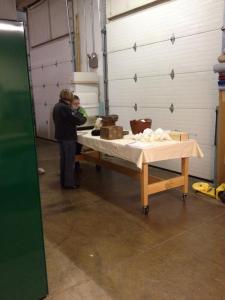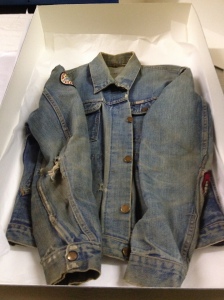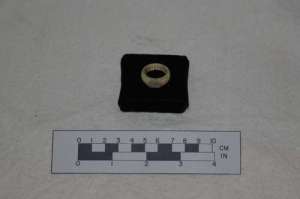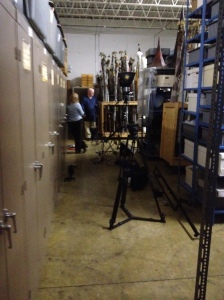Ohio’s Centennial Spirit
Curious about how Ohio celebrated the nation's 100th and 200th birthdays? Learn more about Ohio's Centennial Spirit and how we have celebrated America's founding over the years.
Here at the Ohio History Connection, History Curators are often asked similar questions from the public. We have put together a list of our most frequently asked questions to help explain what we do.

Americorps members help rehouse and organize our hat collection.
What is a collection? A collection is a group of objects that help serve a museums mission. The mission of the Ohio History Connection is to help people connect with Ohio’s past in order to understand the present and create a better future. In order to serve this mission, we have divided our three dimension objects into three collections: history, archaeology, and natural history.
What do you collect? Anything related to Ohio History! We collect anything from hair pins to airplanes; we look for objects that will help visitors connect with Ohio’s history.
Are there things you don’t collect? Much thought and research goes into each donation offer. As stewards, we have to think about space and preservation of our collection. In the History Collection, we sometimes have to turn down objects based on condition, duplication in the collection, or lack of provenance. Provenance is the history behind an object; without knowing the objects history, it can sometimes lose its importance.
How do you research an object? We research an object in a variety of ways. We usually start with the provenance of an object and try to research more about the people associated with object and the historical context the object was used in. We use books and primary sources from the Ohio History Connection Research Library; we also communicate with other museums that have similar objects.
I came to the History Center a few years ago and saw an object that I was interested in. Why isn’t it on exhibit anymore?

H 52949 was recently taken off exhibit after being displayed at the History Center for years. Alan Canfora was wearing this jacket on May 4, 1970, when he was struck by a bullet fired by an Ohio National Guardsman on the campus of Kent State University. To prevent light damage, we have taken it off the exhibit floor, but researchers still have access to it in our collections facility.
We often rotate objects on exhibit for a number of reasons; usually it is to help protect an object from light and environment damage. We also change out objects if we get a better example of that object or just for something new for visitors to see.
What happens if I want to donate an object? First contact the history department. A curator will be in touch to find out more information about the object you wish to donate. If the object is a good fit for the collection, a formal report is made to the Collections Management Team (CMT), a committee made up of curators across all disciplines, who votes on if it should be accepted or not into the collection. History objects are stored in the organization’s collections facility. They are available to researchers by appointment; exhibited at the Ohio History Center and the Ohio History Connection’s 58 sites statewide; and loaned to other museums.
Can you appraise something for me? Ethical and legal reasons prevent Ohio History Connection staff from appraising artworks. The Smithsonian Conservation Institute has put together a list of resources for artifact appraisal.
What does it mean when an object is loaned?

Recently, the Historical Aircraft Squadron borrowed our Culver Cadet airplane for an exhibit at their museum.
Often when museums are putting together exhibitions, they look to other collections to see if there are objects they can borrow to help tell the story in their exhibition. Museums love to collaborate through this processing of loaning objects; it’s win-win, as new audiences can see objects they might not normally have the opportunity to see. As a great example of this, recently our Lilly Martin Spencer painting, Shake Hands? was loaned to the Art Institute of Chicago for their exhibition, Art and Appetite: American Painting, Culture, and Cuisine. As part of the exhibition, Chef Meg Galus of the restaurant NoMI saw the piece and was inspired by it. She likely would never have seen this piece if it had not been loaned.
What is the weirdest thing in your collection? We have a number of unusual objects in our collection. One of my favorite objects is a ring made from bone (H 70407). During the Civil War, Sergeant Peter Heckert, of Company F, 120th Ohio Volunteer Infantry regiment had to have his left leg amputated at Jackson,.

H 70407, a ring made from Sergeant Peter Heckert’s amputated left leg.
Mississippi July 11, 1863. Heckert asked the doctor to save his bone; Heckert made the ring from his own bone and wore it!
What do curators do on a daily basis? Every day is different for curators! We generally process collections, research potential donation offers, work with researchers, plan and chose objects for exhibitions, oversee the care of our collection, take objects out for loans, and work with sites around the state. Sometimes we even get to be on TV to talk about our collection! Of course we also write blog posts and answer questions from readers.

History Curator, Cliff Eckle, films a segment about our Civil War battle flag collection.
How do I become a curator? There is not one singular path to become a curator. This is what makes our field so interesting and diverse! Some curators have come from history backgrounds; others have come from art, design, education, business, or even the science field. I received my M.A. in History Museum Studies from the Cooperstown Graduate Program and interned in a variety of museums in curatorial and digital collections. The key to a career in the museum field is experience! Start volunteering or interning with a museum.
What other questions do you have for the History Curators at the Ohio History Connection?